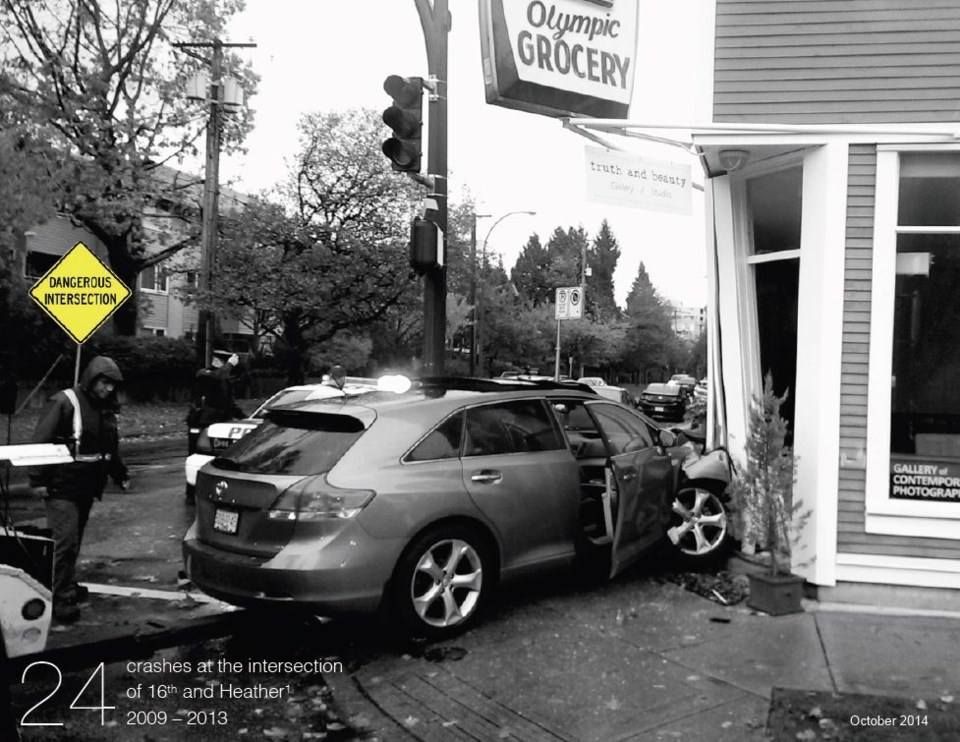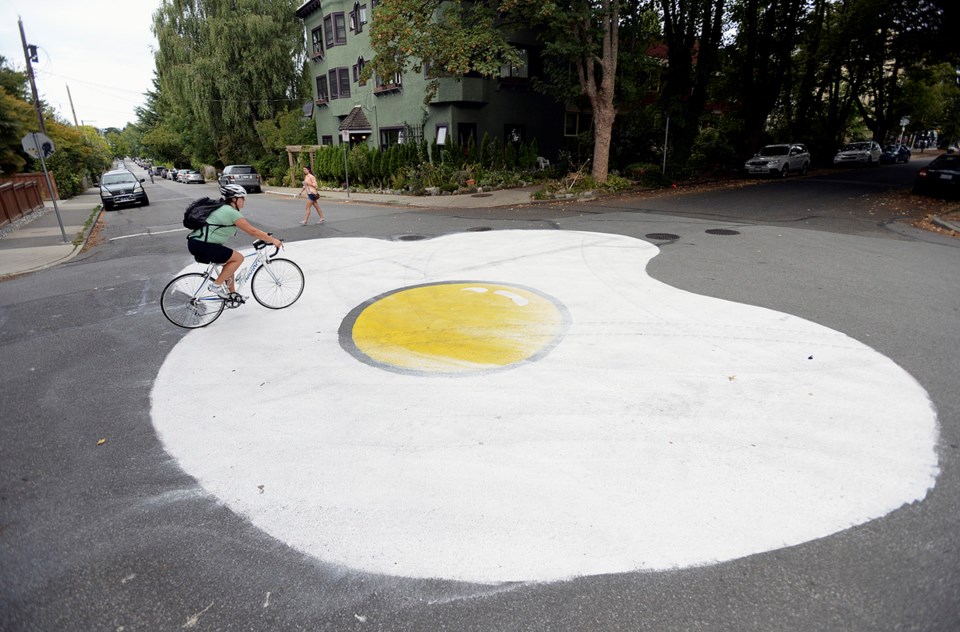When Mark Friesen received a panicked phone call from his wife one April afternoon, he expected the worst.
He raced home to find an SUV protruding from the front window of their apartment building at the corner of West 16th Avenue and Heather Street. His wife Julie, their two daughters, and several neighbours had gathered after the shock to take in the destruction.
Having lived in his building at that intersection for four years, Friesen was abundantly aware of its flaws. It fails anyone not in an automobile, he said.
“We constantly hear the sound of screeching tires, loud horns and near misses from our apartment window,” said Friesen. But it wasn’t until that danger made its way through his front door that he decided it was time to intervene.

He was finishing a master’s degree in Urban Studies from SFU and learned about Portland’s Intersection Repair Program. Officially sanctioned by the city, it provides residents with tools and administrative support to directly address the types of problems he was experiencing.
Friesen call the city of Vancouver and said he, “Quickly learned they had no such formal process in place.”
He also learned 16th Avenue is designated an arterial route by the Streets and Transportation Department. “We knew it was going to be an uphill battle,” Friesen said.
He organized a meeting at the Tandem Bike Cafe— also located at that very intersection — and 18 neighbours showed up. “Each and every person who attended the meeting was motivated by their own personal horror story and a desire for immediate, meaningful change,” Friesen said.
The resulting ideas were compiled in a workbook, which includes illustrations and photos of increased pedestrian space, improved crosswalks, protected cycling facilities and examples of bicycle counters, corrals, street furniture and interactive public art.
“We sent this document to the city engineering department and hope to implement some, if not all, of these concepts sooner rather than later,” said Friesen, who is confident the city will act.
These types of citizen-led interventions are increasingly common in Vancouver. Kitsilano residents painted a giant egg — its yolk shining sunny-side-up on the road at West Fifth Avenue and Trafalgar Street — to draw the curiosity of speeding motorists in order to slow them down.
These are the signs of desperate and frustrated residents who are fed up with the city’s inability to fix decades’ worth of inadequate — and dangerous, I would argue — street design. It’s also anger with the police department’s failure to punish unsafe driving.
I am a huge proponent of traffic-calmed infrastructure like that on Point Grey Road or Adanac Street. I still think it's far too easy for drivers to "rat run" between arterial roads such as Broadway or 12th Avenue onto quiet residential streets. We pride ourselves on not having any freeways within city limits, but it has come at the expense of busy roads spilling onto our neighbourhood streets, with serious implications to the vitality, health and safety of our communities.
Such is the giant game of “whack-a-mole” currently taking place in this and countless other cities. With very limited infrastructure funding at its disposal (an issue, coincidentally, the failed transportation plebiscite would have gone a long way to address), the City of Vancouver can only fix a handful of dangerous intersections each year and otherwise must rely on community-minded citizens to protect themselves and their neighbours.
From a U.S. university design challenge, this is one concept to improve intersections and make them safer for all users:
It’s not just these neighbours’ safety, but their mobility also suffers because people are less likely to walk and cycle on streets designed for cars.
It’s clear this pressing problem won’t be solved with creative paint projects, but requires cohesive, deliberate and well-funded action from the other two levels of government (which, by the way, collect 92 cents of every tax dollar).
These interventions may present some modest successes but are really just Band-Aid solutions on the gaping wounds that bisect our neighbourhoods. Making travel safer for people in cars was the biggest road safety issueof the 20th century. But making streets safer for those outside of cars will be our challenge of the next 100 years.
Chris Bruntlett is a co-founder of Modacity and is inspired to live a happy life of urban mobility. Reach him at chris@modacitylife.com.



